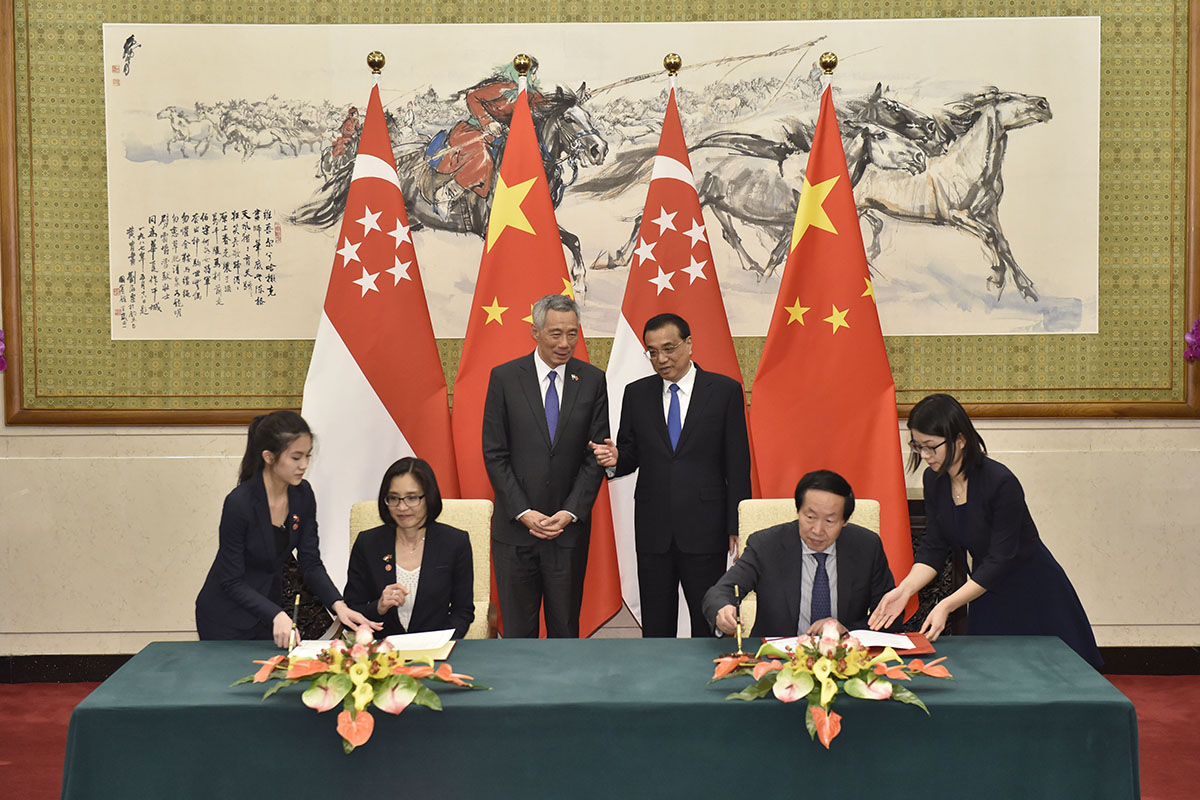With China’s trillion-dollar Belt and Road Initiative (BRI) now in the works, Singapore is not to be side-lined from this grand agenda. On the first day of Singapore Prime Minister, Lee Hsien Loong’s five-day visit to China, he inked an agreement with Beijing to allow for close collaboration between Singapore companies in third party markets in the BRI.
The memorandum of understanding (MoU) was signed by Singapore Minister for National Development and Second Minister for Finance, Lawrence Wong and the People’s Republic of China’s (PRC) National Development and Reform Commission (NDRC) Vice Chairman, Zhang Yong. The NDRC is the lead agency for the BRI.
“This MoU will pave the way for closer partnerships between our companies in third-party markets, one of the key cooperation pillars that Singapore and China have identified under the Belt & Road Initiative. Singapore’s strength as a key infrastructure, financial and legal hub in the region will add value to Chinese companies expanding along the Belt and Road,” said Lim Hng Kiang, Singapore Minister for Trade and Industry.
Under this deal, Singapore’s Ministry of Trade and Industry (MTI), NDRC and Enterprise Singapore will first form a working group and collaborate to identify sectors and markets of mutual interest to all parties. The working group will also organise business matching activities and forums in order to facilitate third-party market cooperation between Singapore and China companies working in the BRI project. Beijing and Singapore will also work with commercial and policy banks, insurers and financial institutions to support the financing and project structuring needs of third-party market ventures by companies from both sides.
Singapore and China first began official bilateral relations in 1990 and for the past 28 years, have had a long and fruitful relationship with one another. Hence, it comes as no surprise that Singapore will play a crucial role within the sprawling architecture of the BRI.

Most significantly, both sides have reaped immense economic benefits thanks to Singapore’s vibrant economy and China’s elaborate investment-ready purse strings. According to a 2017 report by the Economist Intelligence Unit (EIU), Singapore was the most attractive foreign investment destination for China overseas direct investment (ODI) for the year, even surpassing the United States (US) which was ranked first in 2013 and 2015.
Besides that, China’s recognition of Singapore’s geostrategic advantage paved the way for the dual Chongqing Logistics Development Platform (CLDP) and the Multi-Modal Distribution and Connectivity (DC) Centre projects which aimed at developing services, digital and logistical ties between Singapore and the Chinese province of Chongqing. The CLDP which remains at the core of this endeavour is slated to develop the gold standard for multi-modal logistics practices which would strengthen Singapore’s position as a pivotal node within the BRI and wider global connectivity links.
In essence, Singapore would serve as the logistical gateway to the Southeast Asia region for future Chinese investments and trade. This would in turn also serve up a myriad of business opportunities for firms operating within the island republic.
The benefits to China from working with Singapore are also not to be understated. Economic opportunities from the BRI aside, a successful collaboration with Singapore will be a victory for Beijing over Washington in this region.
Export-reliant Singapore has always been at the mercy of global trade conditions. In February this year, the Economic Policy Uncertainty (EPU) Index for Singapore climbed from 126 to 155, indicating that US tariffs have started to bite the island state. With the Trump administration bogged down with domestic strife and with a trade-war trigger-happy President at the helm, now more than ever, Singapore needs a reliable economic partner to lean on. China is ever willing to take up this role.
If Chinese President Xi Jinping’s recent remarks heralding an “open China” is anything to go by, it could mark Beijing’s ascent to the top of the global economic chain. China has been playing second fiddle to the US for quite some time – teasing a rise – ever since the early 1990s. But now, taking into consideration the US’ abysmal trade conduct and China’s riveting views on neoliberal economics coupled with an estimated US$8 trillion infrastructure development plan, it seems like China’s rise is more real now, than it used to be. Being on the receiving end of this is not too bad a situation to be in for Singapore.
